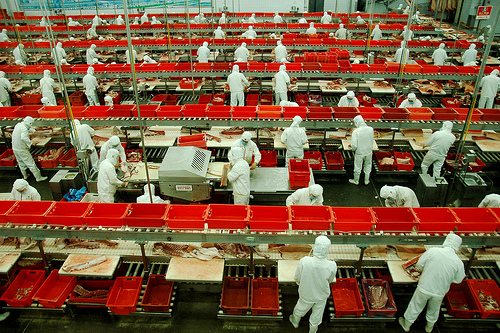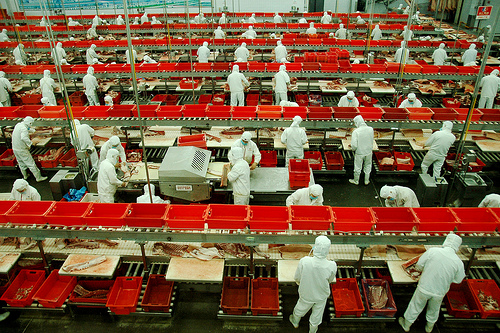 Meating demand: Workers at an industrial meatpacking house in China try to keep up with their nation’s soaring appetite for animal products.Photo: Shreyans BhansaliIt’s Monday, which for many is now a meatless day, so it’s appropriate I think to highlight Howard Schneider’s Washington Post article on the long-anticipated Chinese meat-eating explosion:
Meating demand: Workers at an industrial meatpacking house in China try to keep up with their nation’s soaring appetite for animal products.Photo: Shreyans BhansaliIt’s Monday, which for many is now a meatless day, so it’s appropriate I think to highlight Howard Schneider’s Washington Post article on the long-anticipated Chinese meat-eating explosion:
For China, the world’s most populous country and now its second-largest economy, changes in food consumption are happening fast. In a nation where the word for rice is synonymous with food, people are eating less rice and other grains, preferring pork, fish and, to [chicken farmer] Liu’s delight, chicken. Pig herds are swelling, and demand for some dairy products has been climbing 20 percent a year. Chinese imports of soybeans, a key animal feed, are booming. …
The changing diet can be seen throughout Beijing — from the young people hunkered around tables at a KFC, which has helped build a taste for chicken filet sandwiches, to the profusion of yogurt stocked on grocery shelves.
Farmer Liu, for the record, has tripled his chicken operation in recent years to 25,000 birds and is planning a move up to 60,000. This is the scenario that led the Earth Policy Institute’s President Lester Brown to dub the current rise in food prices “chronic and trend-driven.” In other words, the fundamentals have changed, the food price roller coaster is now on permanent ascent. High prices are here to stay.
One sidenote on Schneider’s reference to rising yogurt sales in China. Paul Roberts, in his excellent book The End of Food, talks at length about Big Food’s “yogurt strategy” in the developing world. Rates of lactose intolerance are apparently much higher in Asia than in Europe and the U.S. (lactose tolerance being a recent development for humanity for which we can thank Northern Europeans) while dairy products are a huge part of the processed food industry’s sales. This represented a major challenge to Big Food’s expansion in Asia. According to Roberts, there has been in place a decades-long plan to use yogurt as a means to introduce dairy into the diets of billions of Asians, since it’s the most easily digestible dairy product. And, if the WaPo is to be believed, the Age of Dairy is now upon the Chinese:
“Particularly over the last two years, [Beijing] has become a huge market,” said a sales representative for Yilli, one of two major local dairy companies.
Dressed in a Minnie Mouse costume to promote a drinkable yogurt branded with Disney characters, she ticked off the benefits of the flavors blended with fruit, vegetables, and grains to try to suit the local palate. Stretching across an entire back wall at a Wal-Mart Supercenter were pumpkin and oat yogurt, pineapple and barley, red bean and mulberry, aloe, lichi and grape, yogurt with tuckahoe (an herb considered good for the spleen) and yogurt mixed with gelatinized donkey skin (said to have been an emperor’s favored energy drink).
According to reports from the U.S. Foreign Agriculture Service, Chinese yogurt sales grew 15 percent in 2009, and dairy consumption overall is expanding 10 percent a year. Since dairy consumption remains low by the standards of the developed world, the report noted, it is expected to continue growing fast. The government plans to double dairy production by 2013, adding millions of cows to the dairy herd.
Aside from the increased climate risk of the skyrocketing increase in Chinese meat and dairy consumption, Schneider observes the symbiotic relationship between American Big Ag and Chinese livestock growers. While China has stayed self-sufficient in grain by and large (though that may soon change; Schneider referred in passing to a growing Chinese interest in biofuels and its wheat production is failing to keep up with demand), Chinese soybean production has held steady since the 1990s and falls far short of meeting domestic demand. Indeed, almost half of the soy given to Chinese livestock comes from the United States — and as a result Americans and Chinese consumers are in direct competition when it comes to livestock feed. With floods and drought plaguing American farmers, that competition is unlikely to end well for anyone.
This is, one must point out, totally unsustainable. Something will, no doubt, give — and unlike Michael Specter, the starry-eyed technology writer for the New Yorker who has a taste for GMOs and lab-grown meat [$ub req], I’m not so confident that science will “solve” these problems for us. Either we will have to restructure our food system to reduce our own meat consumption or the market will do it for us in the form of sky-high prices for meat. Anyone willing to place a bet on which path Americans will take?



